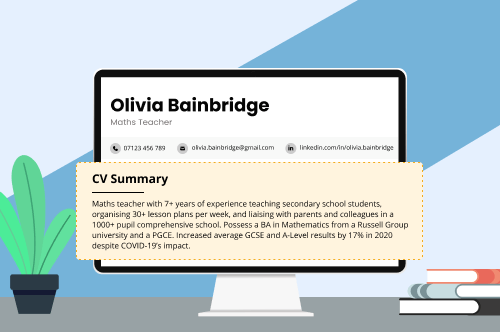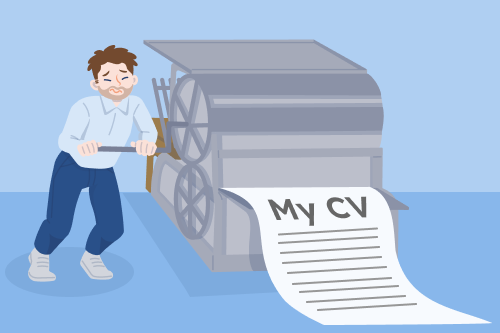When you write your CV, every detail counts.
Whether it’s in your CV layout, word choice, or the sections you include in your CV, how you present yourself in your job application can mark the difference between a job interview and a politely worded rejection email.
Looking at examples of CVs that wowed employers is a great way to improve your CV writing skills and win more job interviews. But sometimes, those well-intentioned yet poorly executed job applications best illustrate the guidelines for creating a perfect CV.
So for purely (*ahem*) educational purposes, here are 11 bad CV examples that show you what to look out for when you write your own:
- The font fiasco
- The spellchecker’s dream
- The clipart catastrophe
- The ‘all cliché and no content’
- The man of few words
- The neverending story
- The formatting headache
- The one that trusted ChatGPT
- The (really) basic Becky
- The employment butterfly
- The straight-up liar
11 bad CV examples
Here are 11 bad CV examples that would struggle to impress any employer in 2024.
To help you avoid making similar mistakes in your own application, we’ve also outlined how you can succeed where these unfortunate job seekers so sorely stumbled.
1. The font fiasco
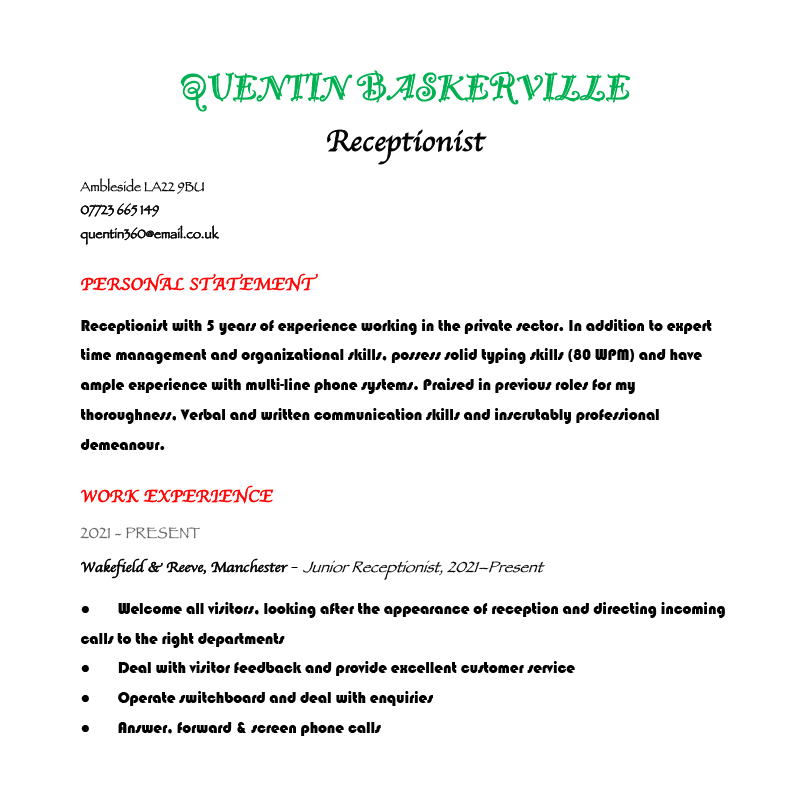
Using the wrong font is a good way to undermine an otherwise great CV.
Overly cursive, boxy, or similarly decorative fonts are off-putting to employers because they’re difficult to read and make your application look unprofessional.
Worst fonts to use on a CV
- Papyrus
- Comic Sans
- Bauhaus
- Apple Chancery
Instead, use a clean, widely recognisable font that employers can scan easily for important information.
Using an appropriate CV font is increasingly important as many employers use applicant tracking systems (ATS) to scan CVs for relevant information before they read them.
Best fonts to use on a CV (and pass an ATS)
- Arial
- Times New Roman
- Verdana
- Lato
- Georgia
2. The spellchecker’s nightmare

Typos and spelling errors are arguably the easiest CV mistakes to avoid — but they’re also among the most common.
In a 2022 study of 147,000 UK CVs, over 60% contained at least one spelling mistake, which is an extra reason to thoroughly check your applications before sending them to employers. Job vacancies are falling in the UK, meaning employers can be picky about which candidates to push through to the interview stage.
Spelling mistakes can make your CV look sloppy, and they suggest you have poor attention to detail.
To ensure each line of your CV is error-free:
- Scan your CV with a spelling and grammar checker like Grammarly
- Use an editing app like Hemmingway to catch redundancies and flowery language
- Read your CV backwards, starting with the last sentence and working your way up to the header
- Have a friend or family member read through your CV to catch typos and vague writing
3. The clipart catastrophe
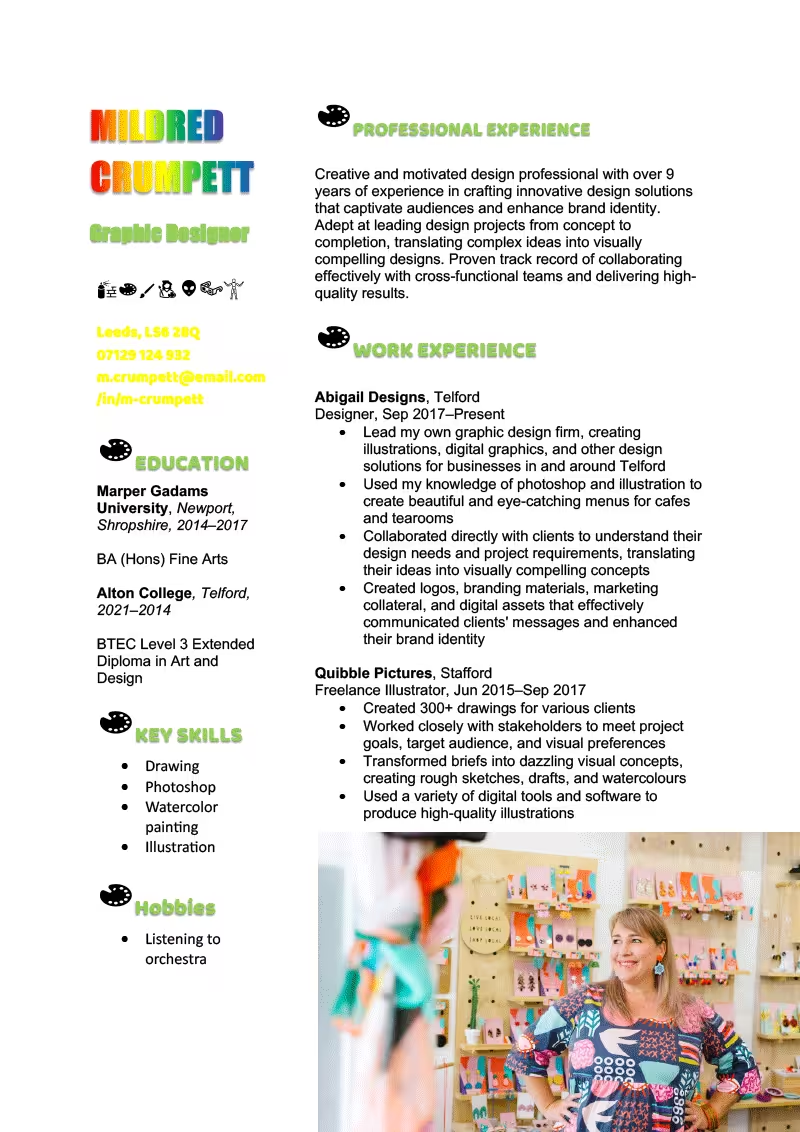
Your CV is should give employers a professional overview of your skills and experiences.
But smattering your CV with flashy graphics hardly screams professionalism.
Visual CVs are appropriate for certain fields, such as UI/UX design, graphic design, or certain marketing roles. But remember that if you take this approach, employers will judge your application based on the quality of the graphics you use.
So avoid clip art, stock images, or any purely decorative graphics. The focus should always be on your skills and experience.
And if you’re applying for a job in a traditional industry, like law or financial services, avoid visual elements altogether and opt for a simple CV template.
4. The ‘all cliché and no content’

We get it — you want your CV to be engaging and persuasive. But stuffing your application with buzzwords and clichés will only get a tired groan from the employer.
Here are a few buzzwords to avoid on your CV:
- Growth-oriented
- Results-driven
- Enthusiastic
- Strategic thinker
- Data-driven
- Cross-functional
- Customer-centric
- Visionary
- Game-changer
- Team player
‘Enthusiastic’, ‘motivated’, and ‘team player’ might sound like great qualities for a job applicant. But these terms don’t say anything specific about your previous achievements or how you’ll benefit the employer if they hire you.
Before sending your CV, read it through and look for any flashy language that doesn’t say anything specific about your expertise:
Dedicated team builder and a natural leader.
Then think about how you can rephrase your writing with clear, more precise language:
Team lead with experience onboarding and mentoring 6 entry-level hires.
5. The man of few words
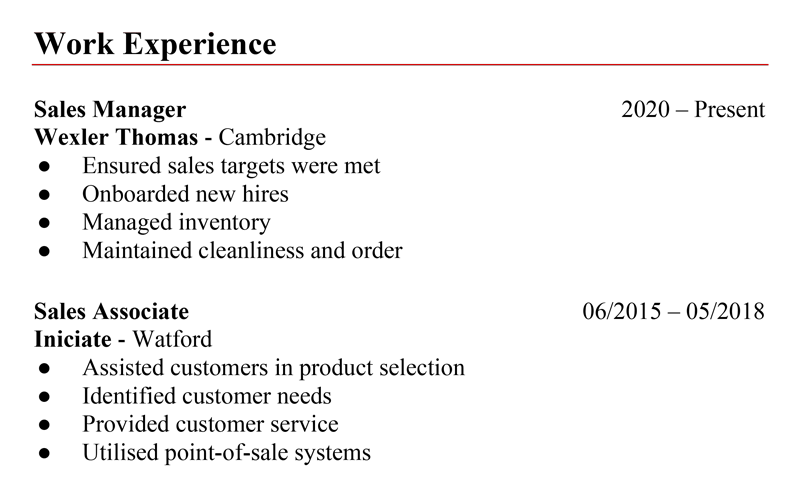
Employers might not want to be hit in the face with a list of buzzwords, but that doesn’t mean you should submit a barebones CV either.
This bad CV example raises more questions than it answers:
- What area of sales was the applicant working in?
- How did they ensure sales targets were met?
- What did maintaining ‘cleanliness and order’ involve?
Writing an extremely short CV can make your job application appear rushed. So explain what benefits your skills delivered in previous roles in at least a full one-page CV if you don’t have enough information to fill a standard two-page application document.
Or if you’re concerned you won’t have enough time to write a professional CV before the application deadline, you can always speed up the process by using an online CV maker.
6. The neverending story

Detail is important in CV writing, but that doesn’t mean you should include everything.
Employers often have to review stacks of CVs in very little time. If your CV looks more like a dissertation, they might give up reading it before they even start.
When writing your CV, focus on relevant details (such as your key skills and industry experience) and keep your CV to 1–2 pages (the ideal CV length). You can address any additional relevant details in your cover letter.
7. The formatting headache
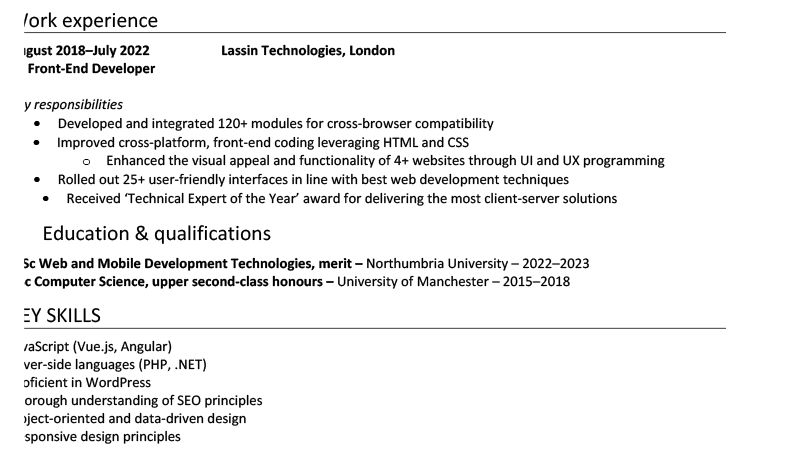
Misaligned bullet points, inappropriately sized margins, and sloppy spacing can all make an otherwise impressive CV look unprofessional.
Time-pressed employers often skim through CVs for key details, so they’ll notice any visual mistakes immediately. Therefore, it’s important to scan the final draft of your CV for any inconsistencies — or use a preformatted CV template and cut out the risk of human error.
8. The one who trusted ChatGPT

ChatGPT can be a valuable resource for writing a CV fast, but the software doesn’t generate an employer-ready application.
Failing to edit and format your ChatGPT CV can lead to various problems after you submit it.
For one, the AI model has no sense of how long a CV should be, often generating lengthy sections that look off-puttingly wordy to most employers.
ChatGPT defaults to US English, so check your CV for American spellings before you send it.
Because it’s trained on large databases of human language, the software may also add inaccurate or untrue information that it thinks is relevant to your situation.
If you’re using ChatGPT to write your CV, it’s important to edit your first draft thoroughly to ensure it’s honest and concise.
9. The (really) basic Becky
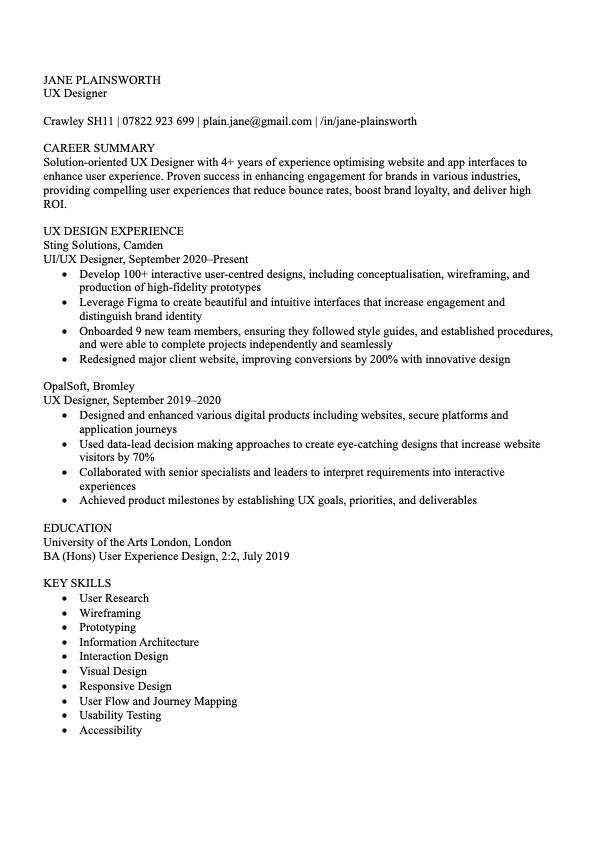
While good CV design should always come second to your skills and experience, an overly plain job application can affect your ability to stand out from other job applicants.
This UX designer might have the right skills and education, but they’re hurting their chances of getting the job they want by failing to demonstrate their creative skills with their CV design.
To avoid underselling yourself with boring formatting, present your expertise on a creative CV that highlights your unique selling points with clever use of colour, white space, and readable fonts.
10. The employment butterfly
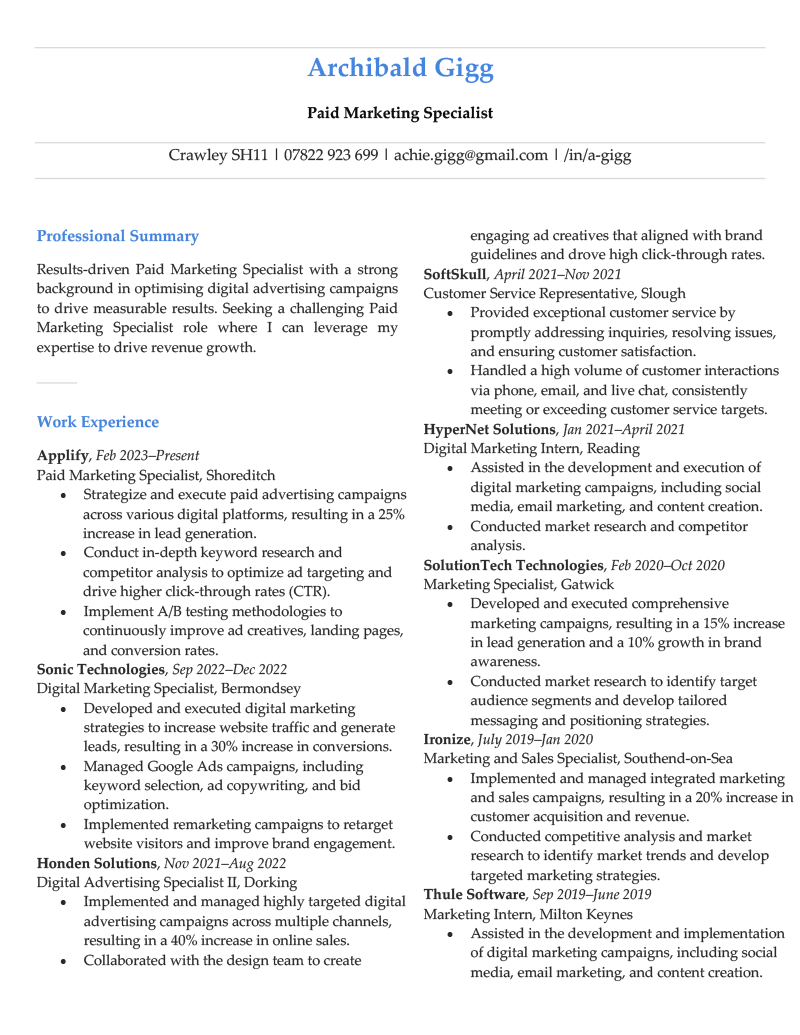
If one thing will raise an employer’s eyebrows, it’s a long list of short work experience entries.
Making a new hire is expensive and time-consuming, so most employers want to hire someone who will remain with the company for at least a few years.
But presenting your work experience as a long list of very short work experiences risks making the employer mistake you for someone who doesn’t take their job seriously.
If you’ve moved around a lot in your career, make a better case for your experience by using a skills-based CV format that emphasises your specific abilities and experience rather than where you worked.
11. The straight-up liar
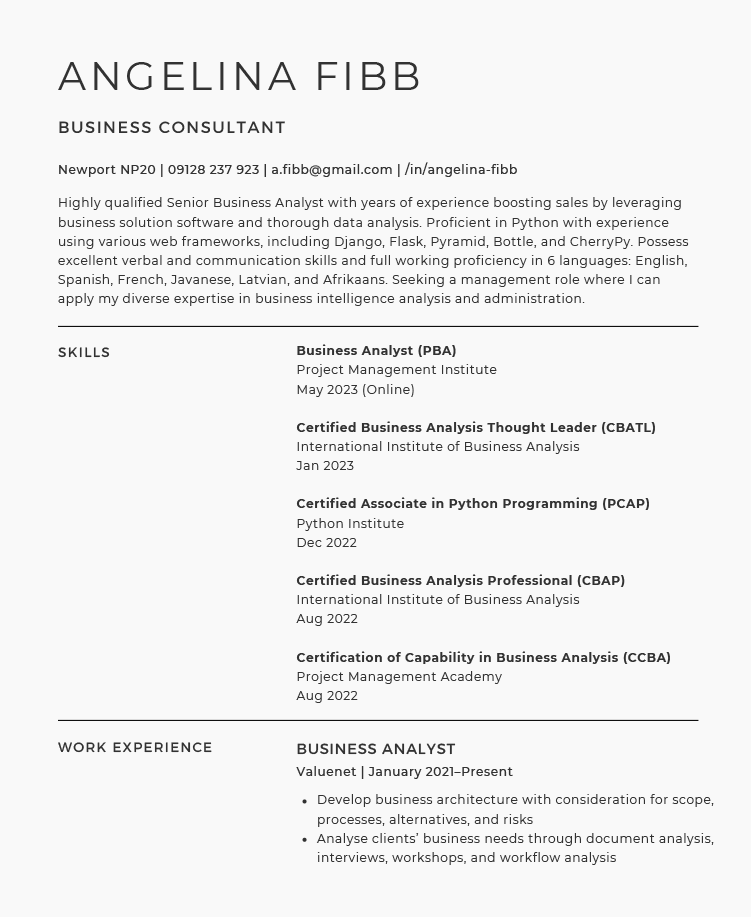
Given how competitive job opportunities can be, many applicants consider bending the truth on their CVs in the hope of having a better shot at getting the job they want.
But lying is never an option.
If adding extra foreign languages, technical skills, or certifications will get your CV noticed, the employer will want to know more when you come in for a job interview — and if your lie is exposed, you’ll have next to zero chance of getting hired.
So unless you actually know how to man the receptionist’s desk in Latvian, don’t suggest that you can on your CV.
Frequently asked questions about CV mistakes and errors
Did these bad CV examples leave you with questions about how to get your CV right? Here are the answers to three common queries:
1. What should you not put on a CV?
Here are 10 things you shouldn’t put on your CV:
- Date of birth
- Race or nationality
- Marital status
- Photo
- Controversial personal information (e.g., your political affiliation)
- List of references (it’s assumed you can provide them on request)
- An unprofessional email address (e.g., cringe.fest123@gmail.com)
- Clip art or unnecessary graphics
- Buzzwords and clichés
- Spelling mistakes and typos
2. Should a CV be totally honest?
Yes, a CV should be totally honest and accurate. Your CV is one of the first pieces of information an employer sees about you, and they’ll use it to assess whether you’re a fit for the job. If it’s discovered that the information on your CV isn’t truthful, your application will be rejected, and your professional reputation could be damaged in the long term.
Instead of lying on your CV, think about how best to market your skills and experiences to the specific job. If you can connect your expertise to the employer’s needs persuasively, you’ll significantly boost your chances of getting hired — and you’ll have done so truthfully.
3. What is the most common CV mistake?
Spelling and grammar errors are the most common CV mistakes. Some of the most commonly misspelt words on CVs and resumes include:
- Experienced
- Successful
- Counselled
- Professional
- Responsible
- Behaviour
- Judgement
- Focused
- Achieved
- Independent
Always check your CV carefully for errors before sending it to an employer, as bad spelling can make your application look rushed and unprofessional — even if you have plenty of relevant experience.
Look out for accidental US spelling when you check your CV for typos, as some UK employers may see them as incorrect.

